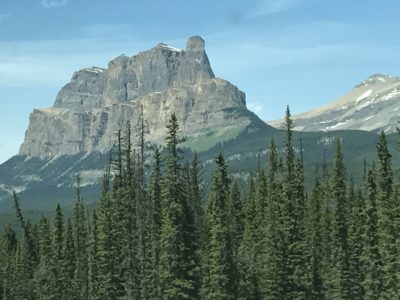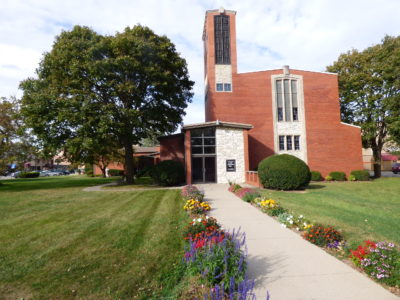
The road from Fairmont Hot Springs, British Columbia to Calgary, Alberta is ultimately scenic. It’s about a three hour drive, which I took a week ago today, with my mom, to take my daughter and son in-law to the Calgary airport. While driving, we saw mountain goats, deer, and a very large moose with wide expanse of rack standing just off the highway. Yes, it was impressive and a bit scary. Our drive also included gorgeous geography like the picture above that I snapped along the way. Deep green spruced forests. Ranges of sharp rising rocky mountains (Castle Mountain above) against deliciously open blue skies. The road from Fairmont to Calgary winds a fair amount. Lots of new views exposed around corners and turns. There was much to be in awe about.
The awe that I perhaps appreciate the most in that drive is the space. You can’t help but be impressed by the open expanse of geography. And, more clearly, it’s the way that that expanse calls out an inner expansive space within me that is so alluring. Space to imagine. Space to feel decompressed. Space to wonder and wander. Space to let go. Space to re-sort some of the inner stirrings. I’ve always loved the people that refer to us humans as nature (not “in nature”). Being in that drive (yes, a mechanical, non-nature vehicle) was pulling out inner nature from within me in a big way.
Most of us live in a culture that values compression. It’s true individually, communally, and organizationally. Doing more. Doing more in less time. Doing more in less time with less resources. Speed and efficiency are so revered and so linked to perceptions of intelligence, accomplishment, and value. It creates pressure, doesn’t it. To fill the moments with more so as to become more (or even curb the impression of losing ground). Yikes!
It was 15 years ago with friend (like a brother, friend) Toke Moeller through whom I first learned this template question that I ask often with people I work with — What could _____ also be? I think the first time I heard him ask it, it was about a school that he was working with in Denmark. What could this school also be? The “also be” is important to me. It honors what is, yet also invites imagination to what is, what what could be, evolving.
Back to space and becoming more, I find myself advocating much these days for the question, what could space also be? What could pause also be? What could emptiness also be? It’s fascinating to me, and also feels as natural and inherent as the feelings that arose when driving near Castle Mountain. What if we were to commit more to a strategic pause and invitation to release reverence for speed and scale (OK, I’m aware that I’m asking a question that calls for more of another kind — space; cultural stories run deep) and the fears that lay beneath them? It’s not a race! It’s not a race to be the last one able to survive amidst scarcity. Yikes again! These are indeed deep cultural stories, but in all fairness, aren’t the only stories that shape cultures — they are just the loud ones.
I know that I’m the kind of human being that deeply values the pause. In facilitation, it often means my desire is to double the amount of time that I plan for a particular section, even though the agenda is often calling for half the time. The pause and the space is fundamental to interrupt patterns and welcome a taste of the new. In individuals. In communities. In organizations. It is my experience, and my continued hope. that the awe and the space, just like it was near Castle Mountain, fills us in different and needed ways.


